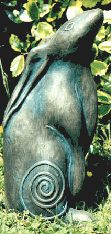 In the Middle East the female hare Akrasha, through her association with the moon and six stars known as Al Thurayya, was thought to drive away evil djinns. Cultures in many places around the world as far apart as India, China, Mexico, Africa, North America, and Europe linked the hare symbolically with the moon, the dawn, the seasons, madness, and sometimes with fire. In Britain the full moon in April was called the ‘hare moon.’
In the Middle East the female hare Akrasha, through her association with the moon and six stars known as Al Thurayya, was thought to drive away evil djinns. Cultures in many places around the world as far apart as India, China, Mexico, Africa, North America, and Europe linked the hare symbolically with the moon, the dawn, the seasons, madness, and sometimes with fire. In Britain the full moon in April was called the ‘hare moon.’
Image: Subject and photographer unknown.
 Image: Subjects and photographer unknown.
Image: Subjects and photographer unknown.
 Eastre (a.k.a. Eostre) was the Great Mother Goddess of the Saxon people of Northern Europe. Her name was derived from the ancient word for spring: eastre. Other variations of the name for goddesses of fertility were Ostare, Ostara, Ostern, Eostra, Eostur, Eastra, Eastur, Austron and Ausos.The female powers in animist cultures were much more powerful to people than the male powers. This was because females had the power to create new life. But, as is described in far more detail in “The ‘Roots’ of Domination,” Section I of Cultural Vision, as tribes became more war-like and domineering, the female goddesses were discarded in favor of male deities. However, the pagans, who lived away from the cultural centers where these male gods were championed, still honored large number of goddesses within their mythologies.As the great exoteric religions became institutionalized, it was difficult to attract ordinary folks, who lived simple agricultural lives in the countryside, to become followers of the new systems of belief. (The word “pagan” means “country dwellers.”) There thus became a concerted effort to demonize their beliefs. In fact, the word “villain” meaning wicked soul, is derived from the word “village.”
Eastre (a.k.a. Eostre) was the Great Mother Goddess of the Saxon people of Northern Europe. Her name was derived from the ancient word for spring: eastre. Other variations of the name for goddesses of fertility were Ostare, Ostara, Ostern, Eostra, Eostur, Eastra, Eastur, Austron and Ausos.The female powers in animist cultures were much more powerful to people than the male powers. This was because females had the power to create new life. But, as is described in far more detail in “The ‘Roots’ of Domination,” Section I of Cultural Vision, as tribes became more war-like and domineering, the female goddesses were discarded in favor of male deities. However, the pagans, who lived away from the cultural centers where these male gods were championed, still honored large number of goddesses within their mythologies.As the great exoteric religions became institutionalized, it was difficult to attract ordinary folks, who lived simple agricultural lives in the countryside, to become followers of the new systems of belief. (The word “pagan” means “country dwellers.”) There thus became a concerted effort to demonize their beliefs. In fact, the word “villain” meaning wicked soul, is derived from the word “village.”
 The character of the March Hare appears in director Tim Burton's 2010 film Alice in Wonderland, voiced by Paul Whitehouse.
The character of the March Hare appears in director Tim Burton's 2010 film Alice in Wonderland, voiced by Paul Whitehouse.
His full name is Thackery Earwicket, and his behavior is constantly nerve wracked and completely delirious. He also has a strong Scottish accent, possibly to match his friend the Mad Hatter (played by Johnny Depp) who switches into a Scottish accent as well whenever his emotions are strained.

The March Hare is first seen in the Tea Party scene, which takes place in the ruined grounds of his Hare House. He is shown having tea with Tarrant Hightop, the Mad Hatter; Mallymkun, the Dormouse; and Chessur, the Cheshire Cat. He is seen a second time in the White Queen's kitchen, frantically cooking and throwing dishes. He is then seen a third time in the Frabjous Day scene, standing with the other characters, and wielding a ladle as his weapon as he waits somewhat nervously to go into battle.



























